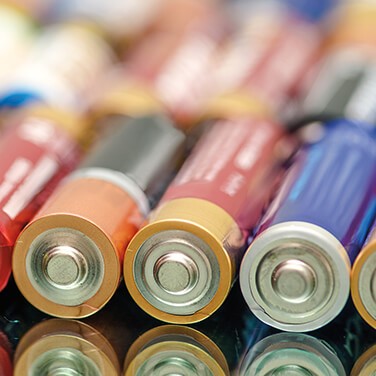Lithium-Air Battery Poised to Take Charge
By Kevin Ritchart
Researchers from the University of Illinois-Chicago and Argonne National Laboratory have designed a new type of lithium-air battery that works in a natural air environment and continues to function after 750 charge/discharge cycles.
Their findings were published earlier this year in the academic journal Nature.
“Our lithium-air battery design represents a revolution in the battery community,” said Amin Salehi-Khojin, assistant professor of mechanical and industrial engineering and co-author of the paper. “This first demonstration of a true lithium-air battery is an important step, but we have more work to do in order to commercialize it.”
Building a Better Battery
For years, researchers have been trying to perfect the design of the lithium-air battery, which can potentially hold up to five times more energy — and operate more safely — than the lithium-ion batteries that currently power cell phones, laptops, and electric cars.
The Federal Aviation Administration (FAA) does not prohibit lithium-ion batteries, but recommends that devices containing lithium-ion batteries be kept in carry-on baggage. Most major airlines don’t permit lithium-ion batteries in checked baggage.
According to the FAA, there were 46 incidents relating to lithium-ion batteries in 2017, an increase from 31 in 2016. The FAA issued a safety alert in 2016 noting that its battery fire testing highlighted a “potential risk of catastrophic aircraft loss due to damage resulting from a lithium battery fire or explosion.”
How They Work
Lithium-air batteries theoretically function by oxidizing lithium at the anode (to produce lithium oxide) while reducing atmospheric oxygen at the cathode to create an electrical current that runs across an electrolyte.
So far, lithium-air battery designs have not operated successfully due to a number of technical issues. Aqueous electrolytes typically react with the lithium metal.
During discharge/recharge, lithium salts may precipitate onto the anode, eventually creating a barrier and blocking the reaction. And chemical changes in solid-electrolyte interfaces produce varying chemical composition and therefore varying output. The cathode can also be compromised by the formation of insoluble lithium oxides.
Improved Design
The UIC-Argonne team was able to prevent anode oxidation and buildup of byproducts on the cathode by utilizing a unique combination of anode, cathode, and electrolyte materials. They coated the anode with a thin layer of lithium carbonate that acts as a filter, selectively allowing lithium ions to reach the electrolyte while simultaneously preventing unwanted compounds from reaching the anode.
Salehi-Khojin and his colleagues made the coating from a unique hybrid electrolyte made of ionic liquid and dimethyl sulfoxide, a common component of battery electrolytes, to help facilitate lithium-oxygen reactions, minimize lithium reactions with other elements in the air, and boost efficiency.
“The complete architectural overhaul we performed on this battery by redesigning every part of it, helped us enable the reactions we wanted to occur and prevent those that would ultimately cause the battery to go dead,” said Salehi-Khojin.
